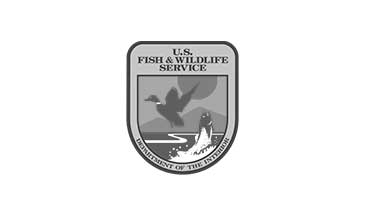Getting Rid of a Raccoon
Do you have a raccoon problem near your property? Get rid of raccoons for good with Varment Guard!
Raccoon Biology
Common Name: Raccoon
Scientific Name: Procyon lotor
- Adult body length (without tail): 18 to 28 inches
- Adult body weight: 5 to 35 pounds
- Gestation period: 63 days
- Litters per year: 1
- Litter size: 2 to 7 young (usually 3 to 5)
- Breeding season: February through March
- Birthing season: April through May
- Age at which young are weaned: 2 to 4 months
- Activity period: Night
- Range: 3 to 20 square miles
- Primary foods: Meats, fish, pet food, seeds, insects, fruits, vegetables
Animal Control: Raccoon Prevention & Exclusion
At Varment Guard, we have a team of experts with the knowledge and tools needed for proper raccoon removal services.
Not only are our services effective in solving your raccoon problem, our ecologically sound methods and humane approach reduce stress on the animal during the removal process. Varment Guard offers:
- Raccoon Trapping & Removal
- Raccoon Exclusion & Prevention
- Raccoon Damage Repair and Inspection of Entry Points
HOW TO GET RID OF RACCOONS
Raccoon Live Trapping
Live trapping raccoons needs to be done by a professional wildlife control team. This is crucial in performing the task correctly and keeping the animal safe.
Live-Catch Wire Cage Traps
Trapping is the preferred method of removal of raccoons, most commonly by the use of live-catch wire cage traps. These traps are baited with a variety of scents raccoons find irresistible (fish, peanut butter, bacon, apple, peach, and berry, for example). Once baited, the traps are placed on the exterior of the home near the point of entry. Traps are checked daily by one of our technicians. During this check, captured animals are removed, traps are re-baited, and adjustments are made to trap placement.
Funnel Traps
Varment Guard technicians are also equipped and trained with funnel-style traps. These traps are placed directly over the point of entry to catch any animals as they leave. This method is successful for stubborn or when trapping shy animals.
Population Control Trapping
An over-abundance or high population of raccoons can be addressed through population control trapping. Baited traps are set along established trails, fence lines, buildings, or other cover used to move throughout the property.
This reduces the risk of raccoons tearing into your home, rummaging through your trash cans, and eating fish from landscape ponds. It also reduces the risk of exposure (people and pets) to the many diseases raccoons can carry.
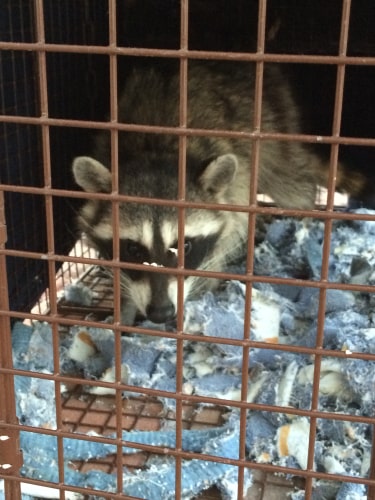
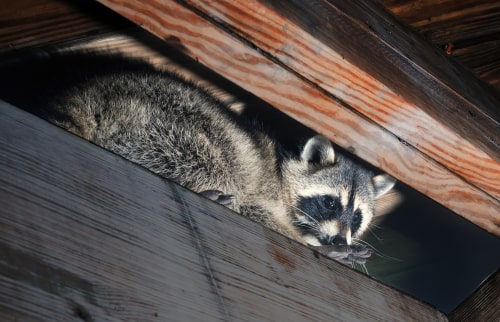
Raccoon Exclusion
Raccoons frequently attempt to create a home in attic spaces and can wreak havoc on insulation. They also commonly seek shelter under decks, porches, sheds, and in chimneys.
Raccoons should be prevented from entering structures by exclusion. Exclusion is a method of preventing animals from entering a structure by installing preventative materials to restrict access points.
Gable vents, soffit vents, and ridge vents can be screened with heavy duty hardware cloth or Ridge-Guard©. Power fans and hat vents can be covered with low profile metal mesh covers. Dormer, corners, roof junctions, siding, roof sheathing, and soffits can all be repaired with the use of metal and caulk. Chimney caps can be installed on open flues. For raccoons going underneath a deck, porch, or shed, buried wire can be installed. All exclusion and prevention installations come with a 5-year warranty.
Raccoon Springtime Removal
Raccoons breed mainly during the late winter to early spring, typically bearing litters of 3-5 young (also known as “kits”) once per year, around February to March. Signs of raccoons with kits present are chattering, squealing, and growling noises that can be heard from the interior of a structure, such as your attic or chimney. This can happen during the day or night, and you may be able to hear more than one at a time. A strong odor may be present in your house, especially if there are raccoon kits present. Most female raccoons will have kits during the springtime, and it is rare to come across one without a litter of kits during this time.
If you suspect or are currently dealing with raccoons with a litter of kits present, schedule a service today and get in touch with one of our expert wildlife technicians so they can help you properly assess and manage your raccoon problems.
Raccoon Behavior & Health Risks
Although raccoons can easily be scared away much of the time, when cornered they can pose a danger to humans and domestic pets. A few of the problems that raccoons can cause include:
Lawn Destruction
Raccoons can be destructive to lawns due to a propensity for “grubbing” behavior. Areas of sod in a lawn can be torn up overnight as a result of raccoon grubbing.
Damage to Entry Points
Raccoons often gain access into attics, basements, and crawl spaces by forcing open loose or broken vent covers, louvers, windows, and carpentry. Raccoons readily invade attics or enter uncapped chimney flues often as a place to birth and wean thor litters of pups.
Fleas and Ticks
Since raccoons are often infested with ticks and various fleas, human occupants and their animal companions can be infested.
Diseases
Raccoon feces accumulate and cause odor and secondary pest problems. They also serve as a potential source of raccoon roundworm infection. Raccoons have been implicated in several other infectious diseases transmissible to humans including leptospirosis, Chagas’ disease, tularemia, and, most notably, rabies.
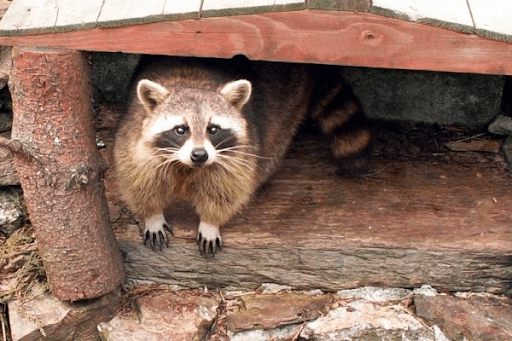
Varment Guard in Action
We are a Certified Installer of RidgeGuard© and XclusionPro from AAC-ProLine™
Ridge-Guard® is a system for guarding against animal entry at the roof ridge. Installation of Ridge-Guard® eliminates the need in most cases of removing old ridge vents. It stops pests without the need for tear-offs of ridge vent or ridge caps. See an example below:
BEFORE
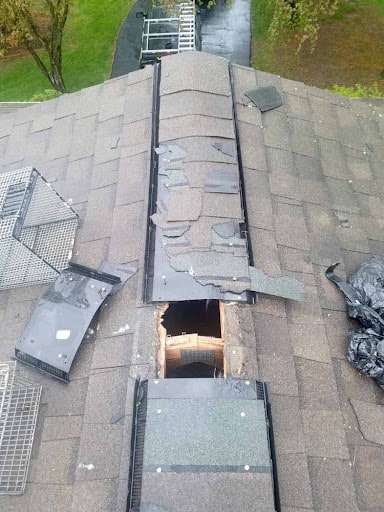
The initial damage was caused by a raccoon gaining access into the attic. Varment Guard replaced damaged shingles and ridge vents prior to installation of Ridge-Guard©.
AFTER
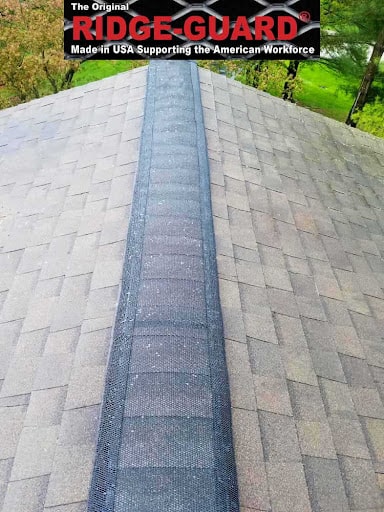
Ridge-Guard© is installed to prevent further entry from nuisance wildlife, like raccoons.
We can rid you of raccoon problems safely and efficiently!
Frequently Asked Questions:
How Can I Identify Raccoon Activity on My Property?
Raccoons leave clear signs such as overturned trash bins, scattered nesting materials, and distinct paw prints. If you notice damage to your lawn or small dens forming around your home, you may have raccoons nearby. Learn more about their behavior.
Are Raccoons Dangerous?
Yes, raccoons can pose risks to humans and pets. They are known to carry diseases such as rabies and leptospirosis and can become aggressive if threatened. Additionally, raccoons may cause structural damage by nesting in attics, crawl spaces, or garages. Read more about raccoon behavior.
What Do Raccoons Eat?
Raccoons are opportunistic feeders and will eat almost anything, including fruits, vegetables, insects, small animals, and garbage. Their diet changes with the seasons, but they always seek out high-calorie food sources to sustain themselves. Keeping food sources secure is one of the best ways to deter raccoons.
How Can I Keep Raccoons Out of My Garage?
To prevent raccoons from entering your garage, secure entry points, seal off vents, and ensure there are no food sources inside. Keep pet food stored properly, and remove any clutter that could create hiding spots. Get more tips for keeping raccoons out of your garage.
What Steps Can I Take to Prevent Raccoons From Nesting on My Property?
The best way to keep raccoons from making a home on your property is to remove attractants. Secure trash cans, block access to potential nesting areas, and use deterrents like motion-activated lights. Learn seven effective ways to prevent raccoons or get in touch with Varment Guard to get rid of your raccoon problem as effectively as possible.
What Should I Do If I See a Raccoon During the Day?
While raccoons are typically nocturnal, they may occasionally be active during the day if they are searching for food. However, a raccoon out in daylight could also be sick or injured. Avoid approaching it and contact a wildlife professional if the raccoon seems disoriented or aggressive.
How Long Do Raccoons Live?
In the wild, raccoons typically live between 2 to 3 years due to predation and environmental hazards. However, in captivity or protected environments, they can live up to 20 years.
Why Are Raccoons Attracted to My Property?
Raccoons are drawn to easily accessible food, water, and shelter. Unsecured garbage, pet food left outdoors, and open crawl spaces or chimneys can all attract them. Preventing access to these resources is the key to keeping them away. If you need help keeping wildlife pests away from your property, contact Varment Guard today.
How Can I Keep Raccoons Out of My Garbage?
Raccoons are notorious for rummaging through trash in search of food. To prevent this:
- Use trash cans with tight-fitting lids or bungee cords
- Keep garbage cans in a locked shed or garage overnight
- Double-bag food waste and rinse out food containers before disposal
- Clean your garbage area regularly to eliminate odors
Read our full blog for more tips!
Do Raccoons Hibernate?
Raccoons do not hibernate, but they do enter a state of torpor, where they become less active in cold weather. They will stay in their dens for long periods, only emerging to search for food when necessary.
What is the Best Way to Remove a Raccoon From My Home?
Raccoons can be aggressive if cornered, and handling them improperly can be dangerous. If you find a raccoon inside your home, avoid contact and call a professional wildlife control company. Experts, like those at Varment Guard, will ensure effective removal while complying with local wildlife laws.

